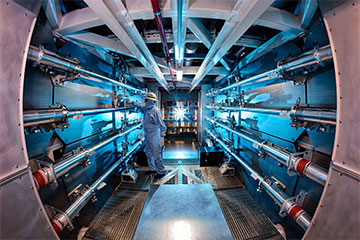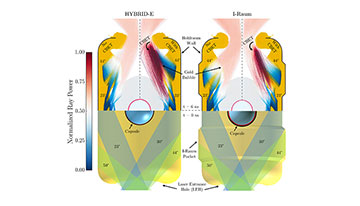
Preamplifiers at the National Ignition Facility, Lawrence Livermore National Laboratory, USA. [Image: LLNL; CC-NC-SA 4.0]
Producing nearly limitless energy from self-sustaining, controlled hydrogen fusion has been a scientific dream for half a century, but technological progress has been slow and fraught with challenges. Researchers at the world’s largest laser facility, however, have reported a key step on the road to fusion: a “burning plasma,” in which the fusion reaction becomes its own predominant source of energy.
Research teams using the National Ignition Facility (NIF) at Lawrence Livermore National Laboratory (LLNL), USA, reported that four experiments conducted on the deuterium and tritium isotopes of hydrogen produced more than 100 kJ of energy, with one yielding approximately 170 kJ (Nature, doi: 10.1038/s41586-021-04281-w).
“A ‘burning plasma’ means that the fusion plasma is heating itself more than we are heating it by external means,” says Omar A. Hurricane, chief scientist for LLNL’s inertial confinement fusion program and one of the authors of the Nature paper. “This is a necessary, and scientifically significant, step on the path toward controlled nuclear fusion.”
To achieve this milestone, the scientists from LLNL and other laboratories improved the geometry of the tiny cavity on which the laser energy is focused and shifted the wavelength of the laser beams inside the confined plasma (Nature Phys., doi: 10.1038/s41567-021-01485-9; arxiv.org/abs/2111.04640).
Powerful lasers, big goals
NIF employs 192 parallel laser beamlines, all amplifying a single laser pulse, that together generate up to 1.9 MJ of energy with peak powers near 500 TW. The facility focuses all that energy on a tiny, hollow gold cylinder called a hohlraum, which in turn contains a peppercorn-sized capsule containing deuterium and tritium. The combined laser beams generate X-rays inside the hohlraum. That huge but fleeting burst of energy momentarily creates temperatures and pressures found only at the center of the sun—or in the explosion of a hydrogen bomb.
US Energy Department researchers began experimenting with NIF’s powerful beams in 2010, but many challenges—some in the details of the interactions between radiation, plasma and other subatomic particles—have delayed the progress toward self-sustaining fusion reactions (see “Laser Fusion: The Uncertain Road to Ignition,” OPN, September 2014).
Illustration of the two inertial confinement fusion (ICF) designs reaching the burning plasma regime. Left: The HYBRID-E cylinder effectively leveraged cross-beam energy transfer (CBET) to control implosion symmetry as the capsule containing fusion fuel grew larger relative to the size of the enclosing radiation cavity, or hohlraum. Right: The I-Raum shaped hohlraum adds “pockets” to displace the wall (and the material blowoff that obstructs laser beam propagation) away from the capsule, controlling implosion symmetry through a combination of geometry and CBET. [Image: Lawrence Livermore National Laboratory (LLNL)] [Enlarge image]
Two paths to the same destination
Of the four NIF experiments that resulted in burning plasma, two used a straight-walled cylindrical hohlraum and the other two employed hohlraums with a slightly narrower waistline around the interior capsule. All four experimental runs exploited a process called cross-beam energy transfer, which is a type of controlled laser-plasma instability. As Hurricane describes it, “essentially by having slightly different wavelengths of light in laser beams that cross each other in a plasma, one can shift energy between the beams.”
“Creating a round implosion is important for maximizing fusion performance out of the capsule, and this is controlled by the balance of X-ray radiation within the hohlraum,” says Christopher V. Young, another LLNL physicist and corresponding author of the Nature Physics paper. “The X-ray drive symmetry seen by the capsule is a combination of (1) the input power balance between the NIF beams that we choose, and (2) the effective power balance between the NIF beams after the cross-beam energy transfer (CBET) process. The amount of energy passed between overlapping beams in a plasma is determined by the difference in wavelength between them (we use 0.5–2 Angstroms typically) and the local plasma conditions (which set up ion acoustic waves that interact with the crossing laser photons).”
Notably, the hohlraum with the slightly narrower waist required less of a wavelength shift in order to maintain the symmetry of the radiation blast. The team—representing nine organizations in the United States, France, Great Britain and Germany—figured this out with a combination of calculations and experiments.
Key to this steppingstone, Young adds, “was finding the right combination of hohlraum gas fill (i.e., local plasma conditions), laser-wavelength detuning and input laser power balance that gives us finer control over the time-dependent X-ray drive symmetry in the hohlraum.”
A preview of things to come?
Hurricane emphasizes that NIF is a research facility geared to exploring inertial confinement fusion, and won’t become a working fusion reactor.
Still, any progress toward the dream of controlled fusion power is encouraging. And more steps could be on the horizon. Since this set of experiments took place in the spring of 2021, LLNL scientists reached another milepost in August 2021: a yield of 1.3 MJ, four times the output of the tests described above, and tantalizingly close to the threshold of fusion ignition. LLNL physicist Annie Kritcher attributes the August result to further refinements in the design of the hohlraum target, and says a formal publication is forthcoming.

